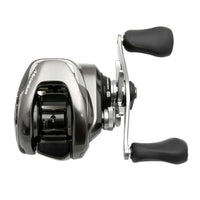Reel Breakdown: Zillion vs. Metanium
Published: Updated:
We're taking a deep dive into two of the most popular reels in our warehouse - the Daiwa Zillion and the Shimano Metanium. Which one are you grabbing this season?
All Featured Products

Daiwa Zillion SV TW Casting Reel
$399.99
Jump to 0:23

Shimano Metanium MGL Casting Reel
$489.99
Jump to 0:30

Daiwa Zillion SV TW Casting Reel
$399.99
Jump to 1:14

Shimano Metanium MGL Casting Reel
$489.99
Jump to 2:49

Daiwa Zillion SV TW Casting Reel
$399.99
Jump to 5:26

Shimano Metanium MGL Casting Reel
$489.99
Jump to 7:26
What's up everybody? Kip here with Omni-Efficient, and today we've got a video that we haven't done for you guys before. In our Rod Bending series, we were getting a lot of comments asking, what kind of reel would you put on those rods? Can you guys do a real comparison? And we thought, we better do something to service you guys. So we are comparing today two of our most popular reels here at Omni-Efficient. That is going to be the Diwazillion and the Shim ano MgL. These two reels have been top sellers here, a couple of my personal favorite re els, and we wanted to break them down and go over some of the differences. We're going to talk about their weight, the frame, line guides, gearing, everything that you need to know to help make your decision when purchasing a higher end reel like this. Before we get into it, if this is a type of video that you guys are interested in, please leave a comment down below what kind of reels do you want to see next? Budget friendly, super high end, we've got it all here, we'd be happy to compare them for you. But without further ado, let's jump into the weight of these re els. We can read it off the box, but we actually have our handy dandy scale here that we're going to give you a real time weight on. So we'll start with the Zillion. This is an aluminum frame and aluminum handle side plate, typically a little bit heavier than some of your more expensive reels, but put it on the scale without line, we are at 6.7 ounces, really lightweight, and it's a 350 dollar reel. The metaneum comes in at about 450, and this is a magnesium frame, lighter weight material, and without line on it, it's at 6.4 ounces. Honestly, not as big of a difference as I expected, but nonetheless, metaneum comes in a little bit lighter than the Zillion. We touched on frames, but we're going to go over some of the bigger features that set these two apart. Starting with the line guide, an often overlooked feature in a reel. If you're a fan of Iowa, you know that Iowa comes with their T-Wing line guide, essentially. When you, the reel is engaged and you're reeling in your line, it's a nice small area for your line to go onto your spool really smoothly. When you're making a cast and the reel is disengaged, it opens up to a wider area, so the line can come through a little bit easier. On the metaneum, you're coming with a standard line guide, but one of the cool things that they did is it's actually cone-shaped. I don't know if you're going to be able to see that, but on the inside of this line guide, it's actually a bigger diameter, and it narrows on the outside, so that line is going to kind of funnel in and theoretically lead to a more controlled cast. I have found from personal use, I run a lot of braid to leader. I do usually tie an F-G knot, but in the earlier days when I was tying an Alberto or even a uni to uni way back, the T-Wing system, if you like to tie a long leader where it gets all the way into your spool, the T-Wing system was a little tough because it does narrow up when you're reeling in that line, and something more traditional, like what you find on the Shimano Reels, was a little bit easier. So, if you're a braid to leader guy, you run a long leader and don't tie an F-G knot, a Shimano line guide, it's kind of where you're going to want to be. All right, let's move into the big selling features for these Reels, their spool and braking system. So, start with the Zillion, this is going to come with your G1 Dura aluminum spool, that's essentially the material that's made out of, and it's going to compact with their SV Boost system. So, previously in the dial line, they had their SV braking system or spool, and this is now their SV Boost. So, the SV Boost essentially gives you braking right off the bat as soon as you make your cast, and then it kind of backs off towards the end, giving you a little bit further cast. I've found that the SV Reels from dial are some of the most controlled reels on the market. Skipping and things of that nature are awesome on an SV Reel. When you open up the side plate, well first of all, you've got your external brake adjustments here on the side, it doesn't get in the way or hand at all, really well designed here. To get into your spool, you're just going to open up this lock, it pops straight out, and you can see here this is there, essentially their braking system, it's a magnetic and centrifugal braking system. This cone sits inside the side plate right here, and essentially when you make your cast, this cone will twist and open up, exposing it more to the magnetic brakes inside of the side plate. As you're reaching the end of your cast, this cone will go back to kind of its resting position, and you'll get a little bit further, a little bit more distance on your cast. So, it's kind of the basics of the SV Boost spool braking system, and moving into the metanium, it's going to feature your MGL 3 spool. And essentially what that means in Shimano's terms is that the spool is going to be heavily ported. You'll see this in a lot of Shimano Reels, but there's going to be holes all the way throughout this spool. And what that's doing is cutting down on weight, and theoretically, lighter weight spool is going to start up faster, it's going to lead to a further cast. What I have found between these two Reels is an MGL spool, specifically in this metanium, is going to cast a mile. It starts up super fast, and you're going to get a super far cast. The zillion, a little bit more controlled, if you're making more precise casts, this is a more controlled reel. So, that's kind of the difference in the spool technology, the braking technology. This has their SVS infinity braking system. Traditionally, the SVS braking system, not the infinity, is what you saw in the older Shimano Reels. Essentially, it was the only internal braking system you pop off the side plate. There are four brake pads on the inside, and you can turn them off or on. The S VS infinity braking system has an external brake adjustment, so you can really dial in where you want your reel to be braking-wise. Once you pop it open, you just twist this core solid body, it's a one-piece body, pop off that side plate, and then in your spool here, you'll see it's got four brake pads, flipping them up, is going to turn them off, having them out, is going to turn them back on. Then, once you've got it where you want to be, you can make micro adjustments with your external brake dial here. So, an upgraded brake system. It's been around for a while now, but you can really fine-till your braking system in this one. The last thing we're going to touch on quick is the internal gearing of the Reels. We're not going to break these apart. We are still planning on selling these, but in the past, the metaneum had been an aluminum main gear reel. Aluminum is lighter than brass, but it is also a harder metal, which is more likely to chip under heavy pressure. They have moved to brass gearing in this, and it does feature their micro-module gearing, essentially smaller gear teeth and more of them. Essentially, that will give you a smoother retrieve, more powerful retrieve, and you can tell in these metaneums. They are buttery smooth right out of the package. In the Zillion SVTW, they also have brass gearing. You will see, if you are a Japan shopper, the Japan Reels have an aluminum gear . The US Reels have a brass gear, and they are claiming that these are going to do the same things. It's their hyperdrive digigear. Essentially, on paper, it's claiming more power and smoother. So, both awesome Reels here from Daiwa and Shimano. One other thing I wanted to touch on was the handle size. I'm kind of a stickler for handle size. The Daiwa comes flat with, I believe, a 90mm handle in all gear ratios. One weird thing that Shimano does is their slower gear ratios. This is a 6'2" to 1". It comes with a 90mm handle, but if you upgrade, or not upgrade, if you go with an 8-speed reel, I think this is an 8'1" to 1". You get a 95mm handle. It might be tough to pick up on camera there, but it comes with a slightly bigger handle. The 8-speed is typically more for your power fishing, so give you a little bit more handle to work with. This runs true for almost all of Shimano's baitcasters from the carado to the SLX, I believe. You 're going to get a little bit longer handle with the higher speed, highest speed gear ratio. So, like I said at the beginning of this video, if you're digging the reel comparisons, we're happy to do more of them. We've got a bunch of them in the warehouse, and these just happen to be the most popular ones that we have right now. Let us know in the comments if you're digging these reel videos. If you want to see more, drop two of your favorites below. We'd be happy to review them, and remember, if you are an OmniaPro member, any of these reels that we're going to talk about, you get 10% back on. So, a $350 reel here, you're going to get 35 bucks back in Omnia credit to spend on whatever you want. So, check out these reels and the hundreds of others we have on the Omnia Fishing website, and get ready for the upcoming fishing season. [Music]
